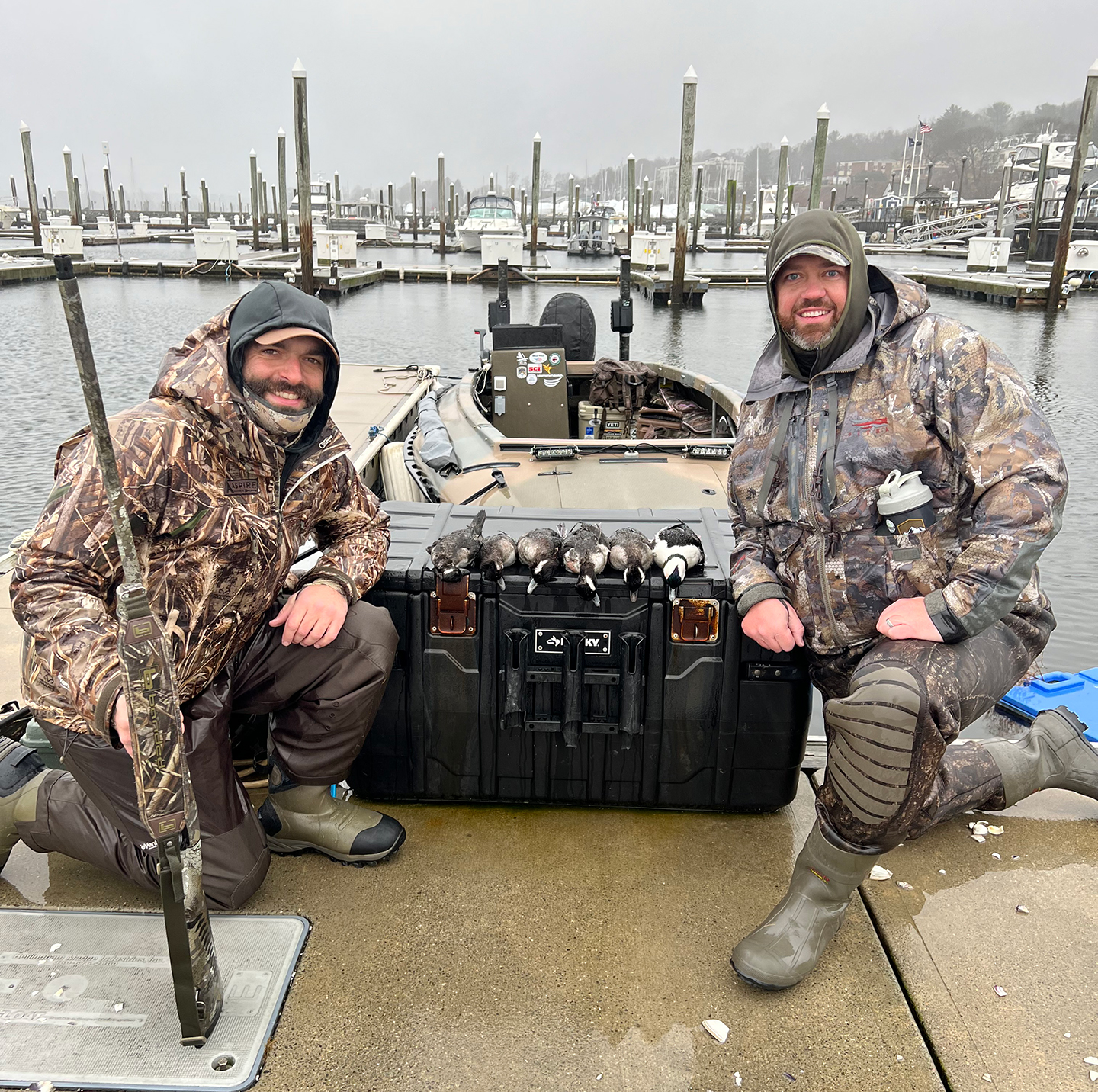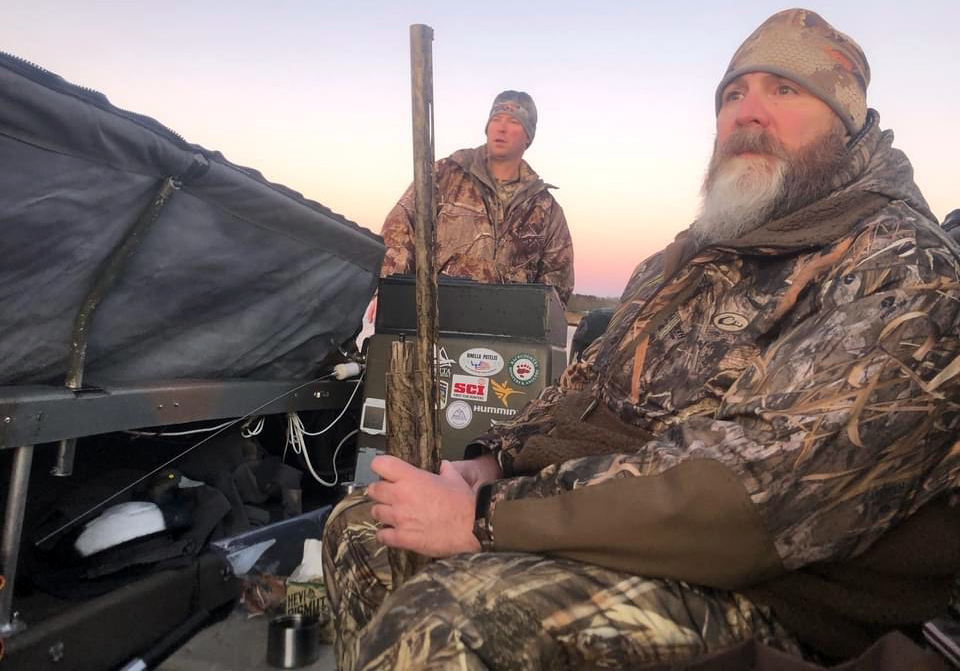Wingshooting with Jarad Luchka
This article originally appeared in Fish Wrap Writer
November 5th, 2023
by Todd Corayer | Duck Hunting, Firearms, Hunting in Rhode Island

One of the most important traditions we New Englanders have is hunting. Many of us have waited months to walk mossy paths, sit on stands and lay in blinds. Whether we wait for deer, sit motionless for turkeys, push through pucker brush for rabbits or study skies for ducks and geese, we savor our time outdoors and hope to bring something home for the table or freezer from an ever-shrinking open landscape. Since success requires planning and because duck hunters have seasons fractured by regulatory closings and ever-fickle weather patterns, I asked an expert about such a cold weather passion. I went wingshooting with Jarad Luchka.
Jarad Luchka is an ace who knows his business
Wingshooting with Jarad Luchka starts from the helm of his 21’ The Duck Boat Company Sea Class boat, USCG Captain Jarad Luchka guides hunters on the Narragansett Bay waterway with his Big Game Waterfowl company. With duck season opening on various October dates in Rhode Island, Massachusetts and Connecticut, I wanted to know how he prepares for a new season, how he reads weather and how he felt about this coming Fall and Winter.
“Starting in the spring when waterfowl nesting is occurring, we hope for a very wet season. This allows for plenty of nesting habitat and allows the birds to spread out. This helps with making food sources more readily available and, not being taxed with condensed populations of birds. It also allows for less predation from coyotes, raccoons, fox, etc,” Jarad explained. So back when we were thinking about the those first migrating striped bass, Jarad was dually focused on how weather would affect waterfowl's fall migration.
“After nesting, it is somewhat status quo until the migration, which coincides with the hunting season. If it is warm, the birds won't really move, as long as there are food sources and ice isn’t forcing them out. This year in particular hurt our early season as the birds didn't want to move due to mild temps. The majority of the birds for the eastern flyway (we have 4 in the US) come from areas of the boreal forest and surrounding northern habitats. In addition to this, birds will typically wait ‘til there is a north wind, so they use less energy. They also enjoy a night with a full moon, less worry from other avian predators like hawks and falcons and they can stay airborne longer.” The four major flyways in America are the Atlantic, Mississippi, Central and Pacific. The Atlantic runs from Greenland to Florida, where waterfowl can pause to feed along salt ponds and flats for small eggs, grasses, invertebrates and grains.

Wingshooters never had a better guide
“Once the season is in full swing, then we not only have the weather issues, but we then have localized factors. So, on a clear, bluebird, calm day, birds will typically fly early in the morning to their food sources and then loaf where they feel comfortable and safe resting. They then may feed again in the afternoon but usually will return to the roost, another safe space for them.” One deciding factor that attracts or repels people considering duck hunting, is that old adage that the worse the weather, the better the shooting. “Now when we get nasty, windy, rain, snowy weather, this helps on many levels,” Jarad said. “First, the birds don’t like to fly in heavy winds,” because that requires, “more energy which means they need more food for migration. They also don’t like to be blown all over the place when they are trying to eat. This will cause them to deviate from their routine and find other birds in feeding areas that are calm and have food and this is where a wise duck hunter shines. So, by placing decoys in calm areas creates the illusion of a safe space with food where the birds can eat, find a mate, and rest.”
Last year, I wanted to try some wingshooting with Jarad Luchka, so I joined Jarad and Ralph Craft for a day on the Bay. Jarad's attention to every detail was unreal. He didn’t just throw decoys in some semi-sheltered cove, he set each piece in a particular order, in a design based on winds and how he thought ducks would fly near us. “Also with all the nasty weather, the decoys will blow around creating movement which the birds like. It also helps obstruct the vision of the birds making tricking them easier with the decoys. And a final bonus is the cloud cover from a nasty storm makes it darker, also eliminating glare and makes them fly later, but sunrise is the same time for us, and the birds don't have a watch and know what legal shooting light is.” Facts.
Rhode Island waterfowl regulations are in the 2023-24 Hunting and Trapping Guide which is available at most tackle and firearms stores. Jarad's boat has a heated deck for those hard and frosty days.
Todd Corayer is a lifelong fisherman and occasional hunter who writes about other people's outdoors adventures while seeing words as puzzle pieces that occasionally all fit together perfectly. You can read more New England fishing reports and stories at www.fishwrapwriter.com.



